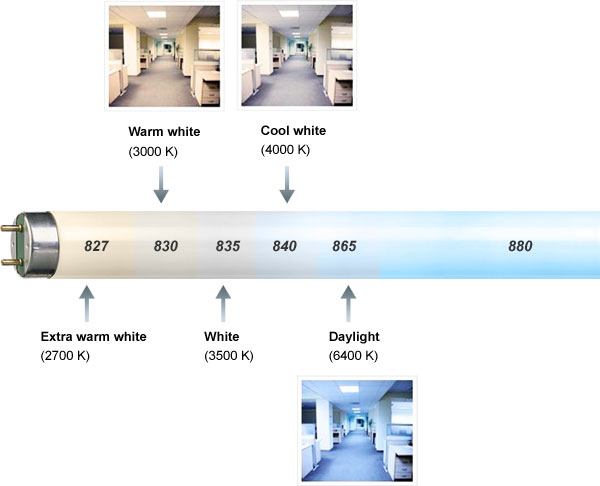Friday: 7:30am – 17:00pm
Saturday: 8:00am – 13:00pm
Saturday: 8:00am – 13:00pm
Colour Temperature
What is a colour temperature?
A colour temperature is a measurement in degrees Kelvin (K) that indicates the hue of a light source.
Although there are special lighting colours (Blue, Yellow, Red...), most lamps are white. However, white can vary from a very warm white to a cool daylight, depending on the temperature of the lamp.
A bit of History
In the 1800s, a British physician, William Kelvin, heated a block of carbon. He saw that the block was red at first, started to turn yellow as the temperature grew, and finished almost to a bright blue colour when the temperature was at its highest level.
The lower the temperature, the redder the colour. The higher the temperature, the bluer the colour.
In lighting, for white lamps, the colour temperatures vary roughly from 2700K, which is the very warm white, to 8000K which is sky white, almost blue.
Below is the temperature scale:

These numbers are colour codes that manufactures use to identify each of their products. Often a tube could be referred to as L18/835. Here the 18 would represent the wattage of the tube and the 835 would refer to the colour temperature, 835 stands for 3500K which is white.
This can get a little confusing if you’re not familiar with the manufacturers’ codes. That’s why we created our own table below as a reference point.
So if you already know which colour temperature you have you can match it up with our manufacturer colour code in the table.
What colour temperature should i choose for my lamp?
All colour temperatures can be used but for different applications.
In general, the warmer light promotes relaxation and then will be suitable for general ambient lighting in housing (bedroom, dining room...) as well as in some public areas.
In contrast, a cooler light will be used to enhance concentration, for example in offices and other working environments.
Finally, hospitals and other medical practices will use daylight lighting. this colour temperature replicates natural light and appears even cooler than cool white. this is important especially in hospitals where patients are constantly indoors and have no other access to natural light.
Below is a list of the different colour temperatures, with some examples of possible applications
Code | Colour Temperature (in Kelvin) | Description | Colour Appearance | Possible applications |
|---|---|---|---|---|
| 827 | 2700K | Very warm white | Similar to incandescent lamp, appear tinged with yellow and gives a warm "cosy" feel | Recommended colour for average household use |
| 830 | 3000K | Warm white | Colour of most halogen lamps, slightly whiter than incandescent | Often used in white rooms for a clean and modern feel. |
| 835 | 3500K | White | Standard colour for many fluorescent and compact fluorescent tubes | |
| 840 | 4000K | Cool white | More clinical feel | Ideal for use in areas where clear illumination is paramount, such as kitchens and offices. Also suitable for general lighting application in factories, parking lots, or warehouses. |
| 865 | 6500K | Daylight | Extremely white, simulate natural daylight | As it is very cold, generally not used for household applications unless specifically desired. Possible applications in horticulture, aquariums... |
| 880 | 8000K | Skywhite | Very cold white, with blue tones | Used in specialist applications such as photography and architechural drawing. |
What does the term “colour rendering” mean?
The Colour Rendering Index (CRI) measures the ability of a light source to reproduce the true colour of an object, in comparison with a reference light source - for example, the sunlight.
For cool lamps, the reference light source is usually the natural daylight, whereas for warmer lamps the reference light source will often be an incandescent light.
Under a lamp with a low CRI, the colours will appear unnatural. So the higher the CRI, the more natural the colours will appear. A high CRI will be particularly useful where the true colour of light is important, e.g. Textile, Printing and Publishing industries. For these particular industries we would recommend the 90ra lamps. On our website we sell the T8 Luimlux Deluxe tubes – these are one of the products with a colour rendering off 90 or higher. A great product for the industries mentioned above.
In 2010, the EU banned the production off all halophosphate tubes due to low efficiency and poor colour rendering. This included the Osram T8 Basic Energy Saver range. We continue to list these on our website as the majority of our customers would still have these tubes within their existing fixtures and would probably get confused if we only listed the other T8 versions. However when an order is placed for these tubes and once our stock has finished within this range we will start to send the T8 Lumilux version of the lamp.


